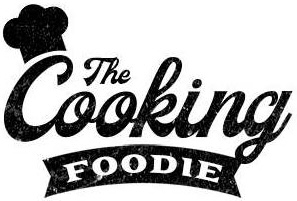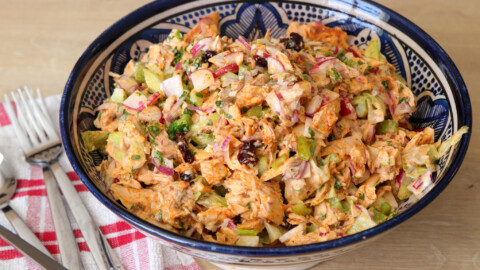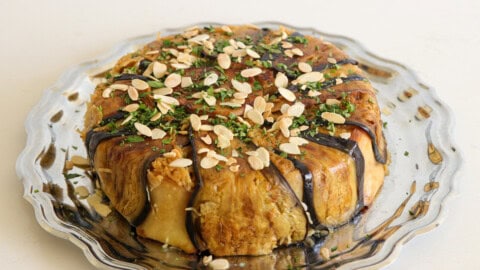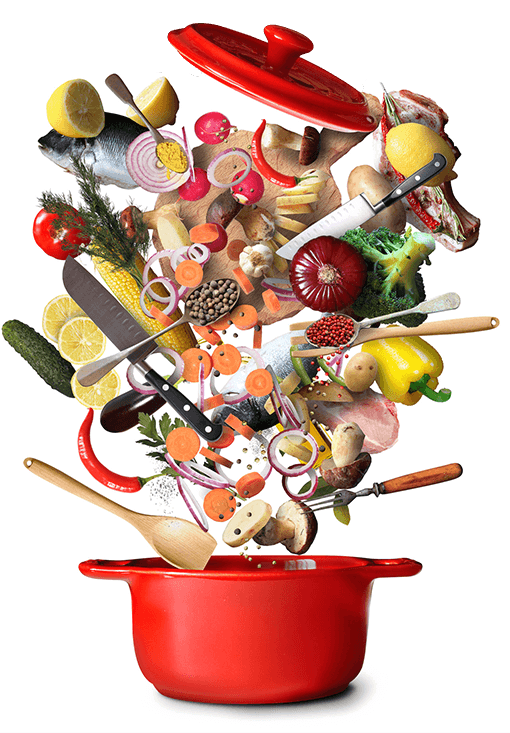Pistachio Crusted Salmon Recipe
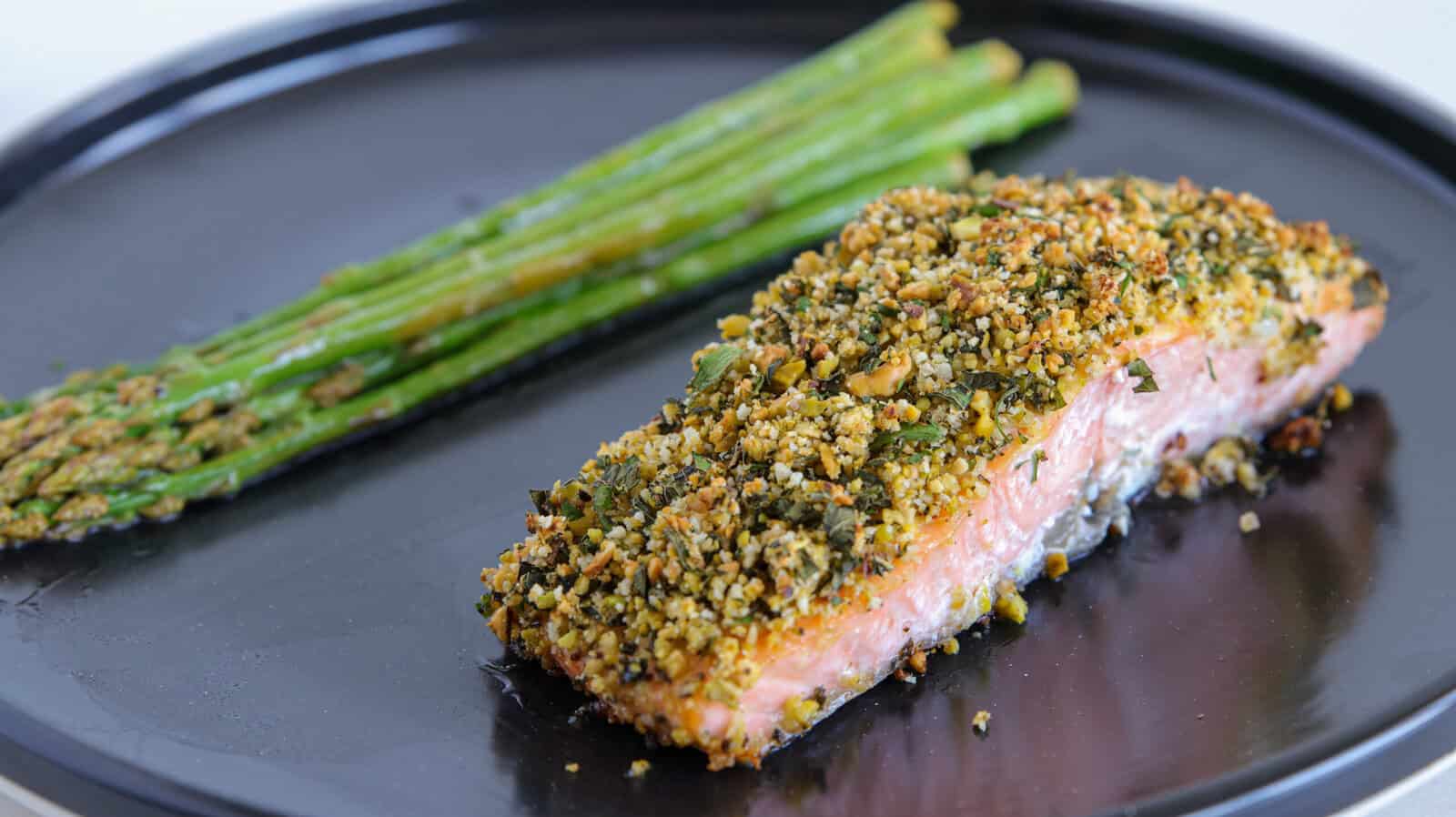
This crusted salmon recipe is the perfect dinner recipe when you want to impress your guests. Quick, easy and delicious salmon recipe with pistachio crust.
INGREDIENTS FOR CRUSTED SALMON
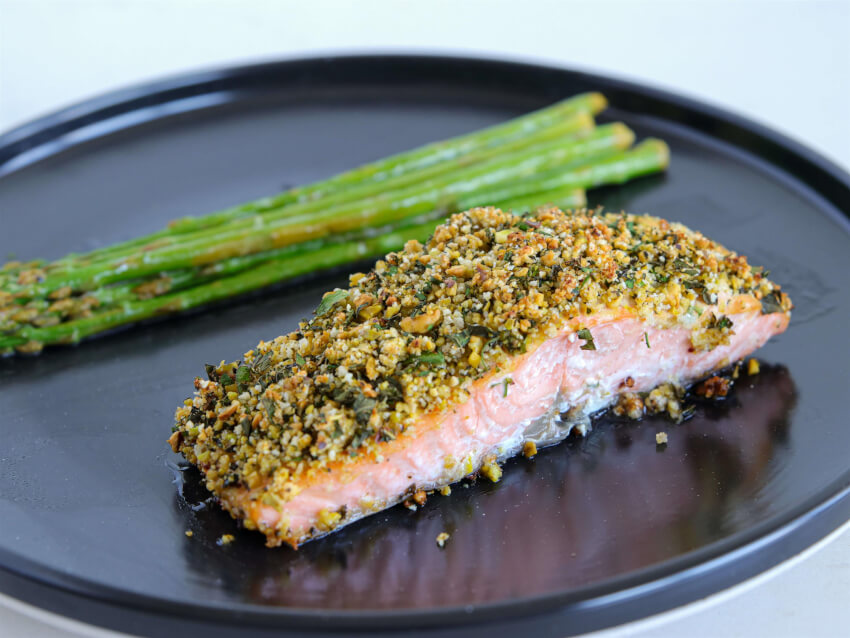
Crusted salmon is a delectable dish that combines the rich, flaky texture of salmon with a flavorful and crunchy crust made from a variety of ingredients. Here’s a list of the key components you’ll need to create this delicious dish:
- Salmon Fillets: Salmon is the star of the show, providing a hearty and healthy protein source. You can use fresh or frozen salmon fillets, and the choice of the type of salmon can be based on your personal preference.
- Nuts (Pistachios or Other Nuts): Nuts such as pistachios add a delightful nutty flavor and crunch to the crust. You can also opt for other nuts like almonds, pecans, or walnuts if you prefer a different flavor profile.
- Coriander/Parsley Leaves: Fresh coriander or parsley leaves contribute a burst of fresh herbiness to the crust. The choice between coriander and parsley can depend on your flavor preference.
- Mint Leaves: Mint leaves infuse a refreshing and aromatic element into the crust. The combination of mint with other herbs creates a harmonious flavor profile.
- Garlic: Minced garlic cloves provide a subtle yet savory kick to the crust. The garlic complements the herbs and nuts for a well-rounded flavor.
- Salt and Pepper to Taste: Seasoning with salt and pepper is essential to enhance the overall taste of the dish. These seasonings bring out the flavors of the salmon and the crust ingredients.
- Lemon Juice: Fresh lemon juice adds a zesty and citrusy note that brightens up the entire dish. It also pairs wonderfully with the richness of the salmon.
- Panko Breadcrumbs: Breadcrumbs serve as the binding agent that holds the crust ingredients together and creates a crispy texture. You can use regular or panko breadcrumbs based on your preference for texture.
- Dijon Mustard: Dijon mustard acts as a flavorful adhesive for the crust, helping it adhere to the salmon fillets. It also imparts a tangy and slightly spicy element to the overall flavor.
When these ingredients are combined and applied to the salmon fillets, they create a harmonious blend of flavors and textures. The nuts and breadcrumbs form a satisfyingly crispy outer layer, while the herbs, garlic, and mustard infuse the salmon with a medley of savory, herbaceous, and tangy notes. The end result is a crusted salmon dish that is as visually appealing as it is delicious, making it a perfect choice for a special meal or a delightful weeknight dinner.
TIPS TO MAKE THE BEST CRUSTED SALMON
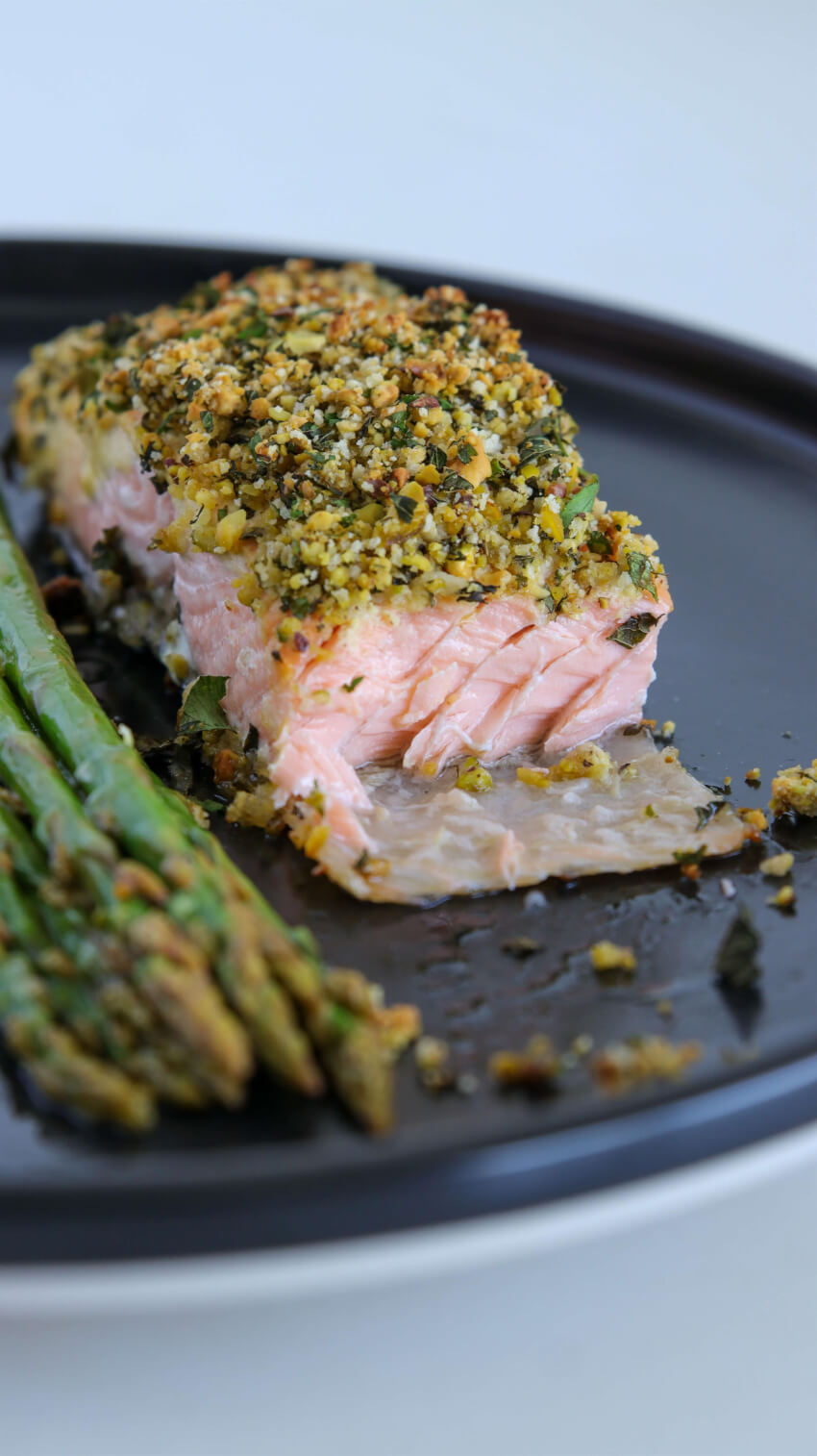
To create the best-crusted salmon, you’ll want to pay attention to various aspects of the cooking process. Here are some tips to help you achieve a perfectly crusted salmon:
- Select Quality Salmon: Start with fresh, high-quality salmon fillets. Look for fillets with vibrant color and a fresh smell. Choose salmon that is sustainably sourced if possible.
- Pat the Salmon Dry: Before applying the crust, pat the salmon fillets dry with a paper towel. Excess moisture can prevent the crust from adhering properly and becoming crispy.
- Prepare the Crust Ingredients: Ensure that all the crust ingredients are finely chopped or processed, including nuts, herbs, and garlic. This will help create a more cohesive and even crust.
- Season Generously: Season the salmon fillets with salt, pepper, and a touch of lemon juice before applying the crust. Proper seasoning enhances the flavor of the fish.
- Use Dijon Mustard Sparingly: Apply a thin layer of Dijon mustard on the salmon fillets to help the crust adhere. Use it sparingly, as too much can overpower the dish.
- Press the Crust Firmly: Press the crust mixture onto the salmon fillets firmly but gently to ensure it sticks. You can use the back of a spoon to do this. Evenly distribute the crust to avoid uneven cooking.
- Serve with Accompaniments: Crusted salmon pairs well with side dishes like steamed vegetables, roasted potatoes, or a fresh salad. Consider serving it with a sauce like a lemon butter or yogurt dill sauce for added flavor.
- Experiment with Different Nuts and Herbs: Don’t hesitate to experiment with various nuts and herbs to create unique flavor profiles. Almonds, pecans, or walnuts can be used in place of pistachios, and you can vary the herbs to your liking.
HOW TO STORE PISTACHIO CRUSTED SALMON?
Storing pistachio-crusted salmon properly is essential to maintain its freshness and quality. Here’s how to store leftover pistachio-crusted salmon:
- Refrigeration: If you have leftover pistachio-crusted salmon, wrap it tightly in plastic wrap or aluminum foil. Alternatively, you can place it in an airtight container.
- Label and Date: For easy identification and to keep track of freshness, it’s a good practice to label and date the packaging.
- Refrigerate: Store the wrapped or containerized salmon in the refrigerator. Place it on a shelf rather than in the door, as temperatures can fluctuate in the door, affecting the quality of the food.
- Consume Quickly: Try to consume the leftover pistachio-crusted salmon within 1-2 days. While it’s still safe to eat after this time, the quality may degrade, and the crust might become less crispy.
- Reheat with Care: If you want to reheat the leftover salmon, do so in an oven or toaster oven rather than a microwave. Microwaving can make the crust soggy. Reheat it at a low to moderate temperature (around 325-350°F or 160-175°C) for a short period to avoid overcooking.
Proper storage and handling will help maintain the flavor and texture of your pistachio-crusted salmon. Avoid leaving it at room temperature for extended periods and be mindful of temperature fluctuations to ensure that your leftovers remain safe and enjoyable to eat.
HOW CAN I MAKE PANKO CREUSTED SALMON GLUTEN FREE?
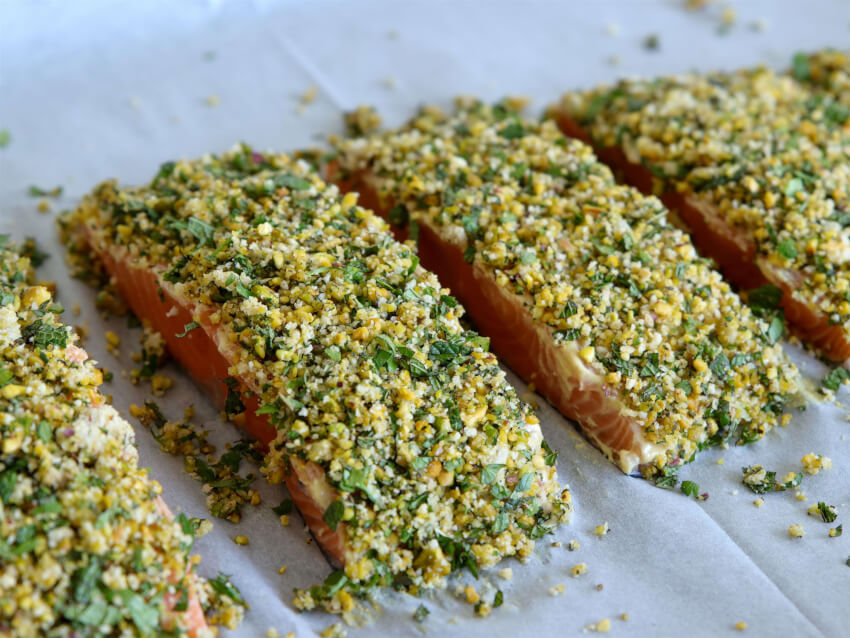
To make a gluten-free panko-crusted salmon, you can use gluten-free breadcrumbs as a substitute for regular panko breadcrumbs. These gluten-free breadcrumbs are made from gluten-free bread and can be found in most grocery stores. When following your favorite panko-crusted salmon recipe, simply replace the regular breadcrumbs with the gluten-free version. The rest of the preparation, including adding fresh herbs, minced garlic, seasonings, and cooking techniques, remains the same. This adjustment allows you to enjoy the same crispy, flavorful crust on your salmon while accommodating a gluten-free diet.
WHAT TO SERVE PISTACHIO CRSUTED SALMON?
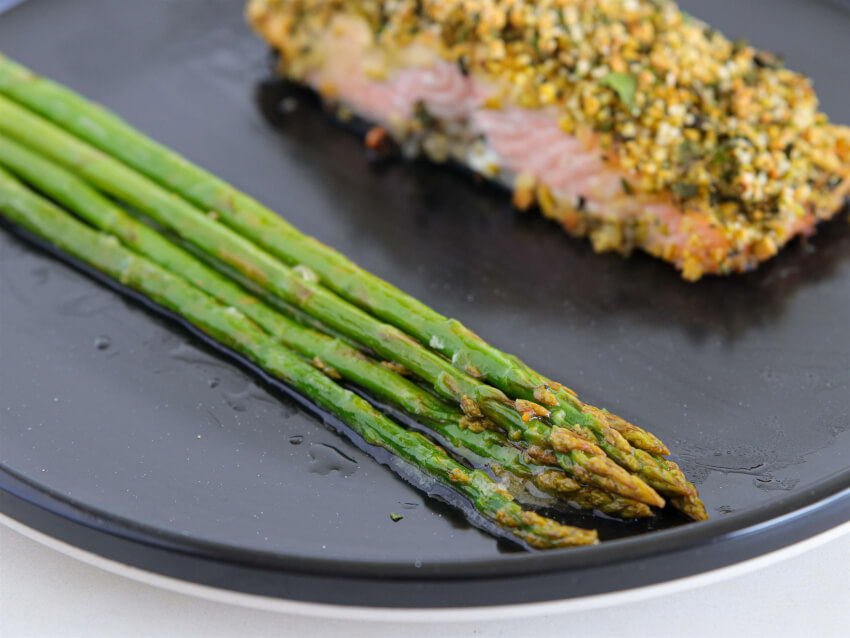
When serving pistachio-crusted salmon, it’s essential to pair it with side dishes that complement the rich, nutty flavors of the dish. In this recipe, I mentioned serving it with lemon butter asparagus, which is an excellent choice. However, you have plenty of other options to consider, depending on your preferences and the occasion:
- Lemon Butter Asparagus (as mentioned): Asparagus is a classic and vibrant side dish that pairs wonderfully with the citrusy and nutty notes of the salmon. The lemon butter sauce adds a delightful zing.
- Green Salad: any fresh salad that you like, with greens or other vegetables. The options are endless.
- Garlic Mashed Potatoes: Creamy mashed potatoes with roasted garlic provide a comforting and hearty accompaniment to the pistachio-crusted salmon.
- Quinoa Salad: A fresh and herb-filled quinoa salad with cherry tomatoes, cucumbers, and a lemon vinaigrette can balance the richness of the salmon.
- Roasted Vegetables: A medley of roasted vegetables, such as carrots, bell peppers, and zucchini, can be seasoned with herbs and olive oil for a colorful and healthy side.
- Green Beans Almondine: Tender green beans sautéed with sliced almonds in butter offer a simple and elegant side that pairs well with the nutty crust.
- Creamed Spinach: Creamed spinach provides a rich and velvety side dish that adds a comforting contrast to the crispy salmon.
- Mixed Greens Salad: A light mixed greens salad with a vinaigrette dressing can serve as a refreshing and healthy side that doesn’t overpower the salmon’s flavors.
- Lemon Herb Couscous: Fluffy couscous tossed with lemon zest and a variety of fresh herbs, such as parsley and dill, can enhance the citrus and herbaceous notes of the salmon.
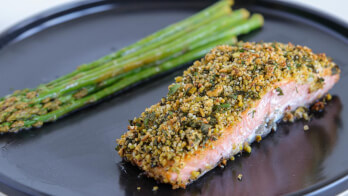
Pistachio Crusted Salmon Recipe
Ingredients
For the salmon:
- 4-5 Salmon fillets
- ½ cup Pistachios *you can use any other nuts
- 2 tablespoons Coriander/parsley leaves chopped
- 2 tablespoons Mint leaves chopped
- 1-2 garlic cloves minced
- Salt to taste
- Pepper to taste
- 2 tablespoons Lemon juice
- ⅓ cup Breadcrumbs
- 1-2 tablespoons Dijon mustard
For serving (optional):
- Asparagus
- 1-2 teaspoons Olive oil
- 2 tablespoons 30g Butter, unsalted
- 2 tablespoons Lemon juice
- Lemon zest from one lemon
Instructions
- DIRECTIONS
- For the salmon: Preheat oven to 375F (190C). Line baking tray with parchment paper and set aside.
- Make the crust mixture: place pistachios in a blender and blend into fine crumbs (you also can do It by chopping with a knife), transfer into a bowl. Then dd breadcrumbs, garlic, parsley, mint, salt, pepper, lemon juice and mix well.
- Place salmon on the prepared baking sheet. Season each fillet with salt and pepper. Brush each salmon fillet with mustard, then sprinkle the crust mixture on top of each fillet and lightly press.
- Bake for 15 minutes or until salmon flakes easily with fork.
- For the side (optional): cut the ends of the asparagus.
- Fill a large pot with water and bring to a boil. When boiling, blanch the asparagus for 30 seconds. Then, immediately transfer to a bowl with ice water and allow to cool.
- In a medium pan, drizzle olive oil and add butter. Melt over medium heat. Add the asparagus. Add lemon zest and sauté for 2 minutes.
- Serve with baked salmon.
